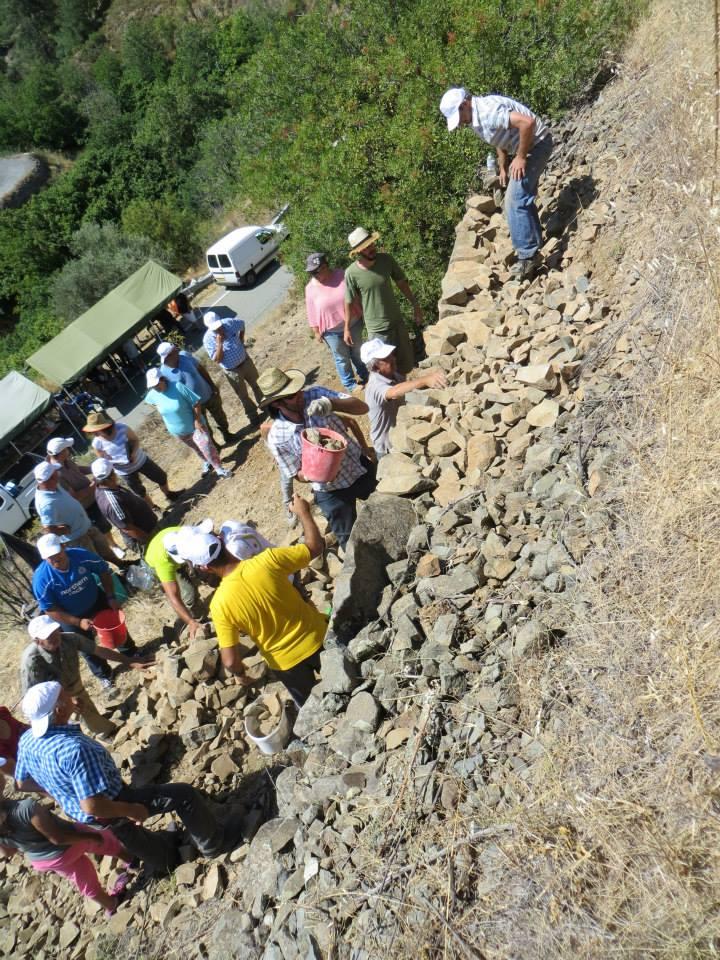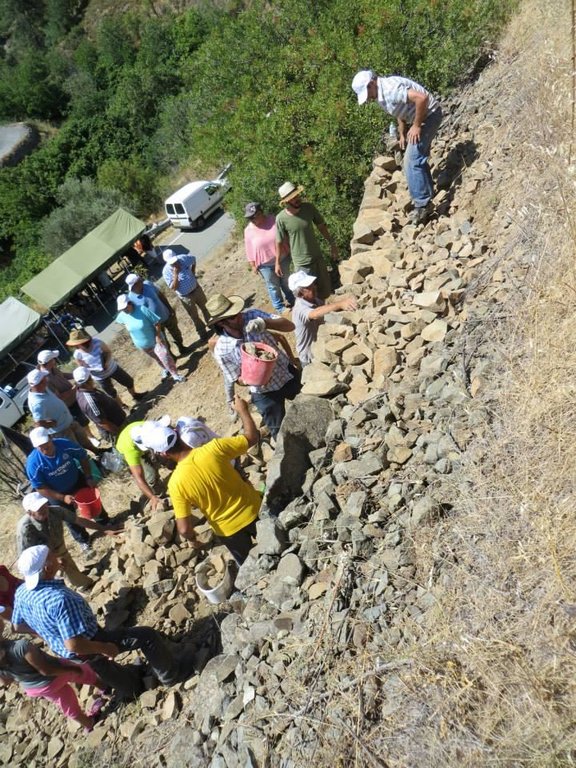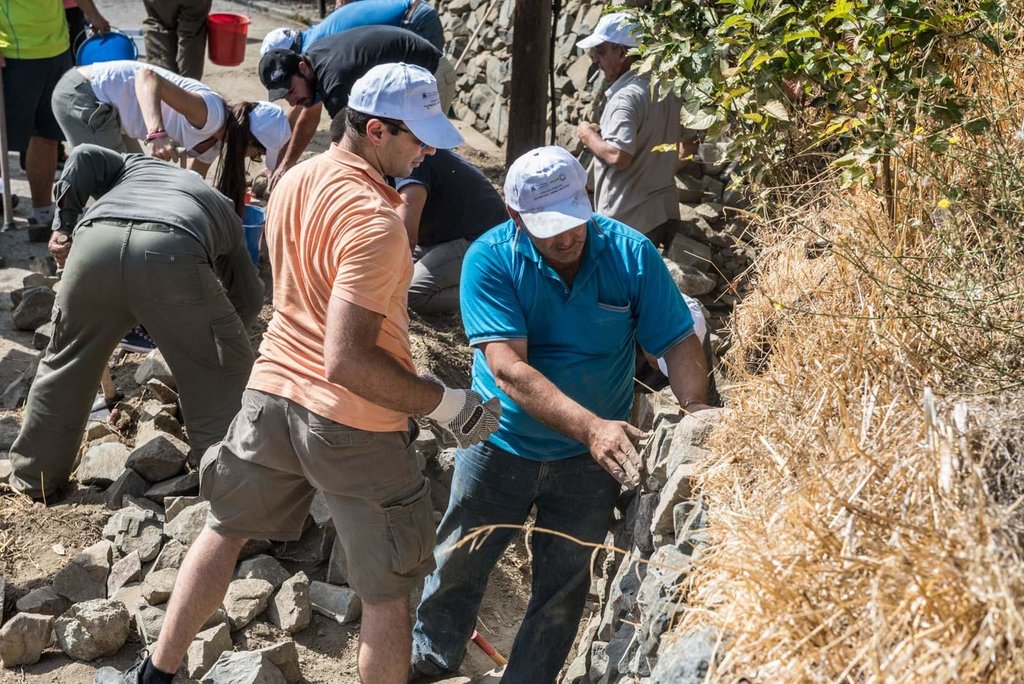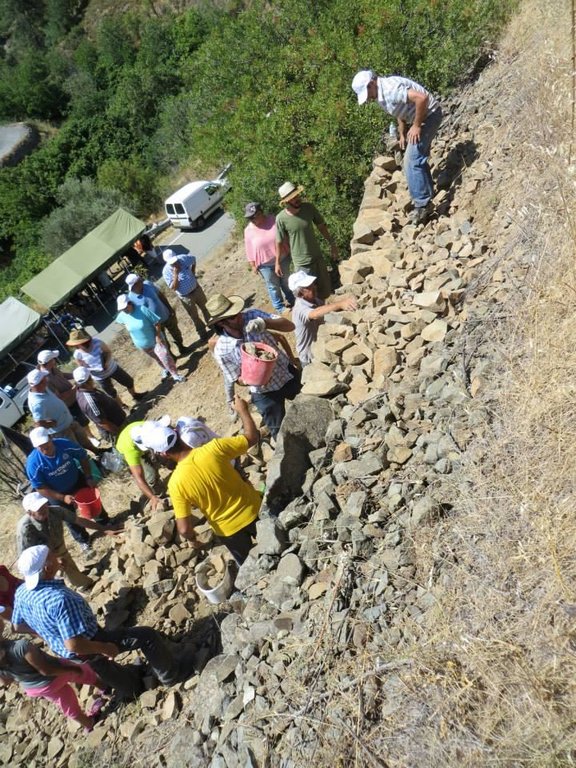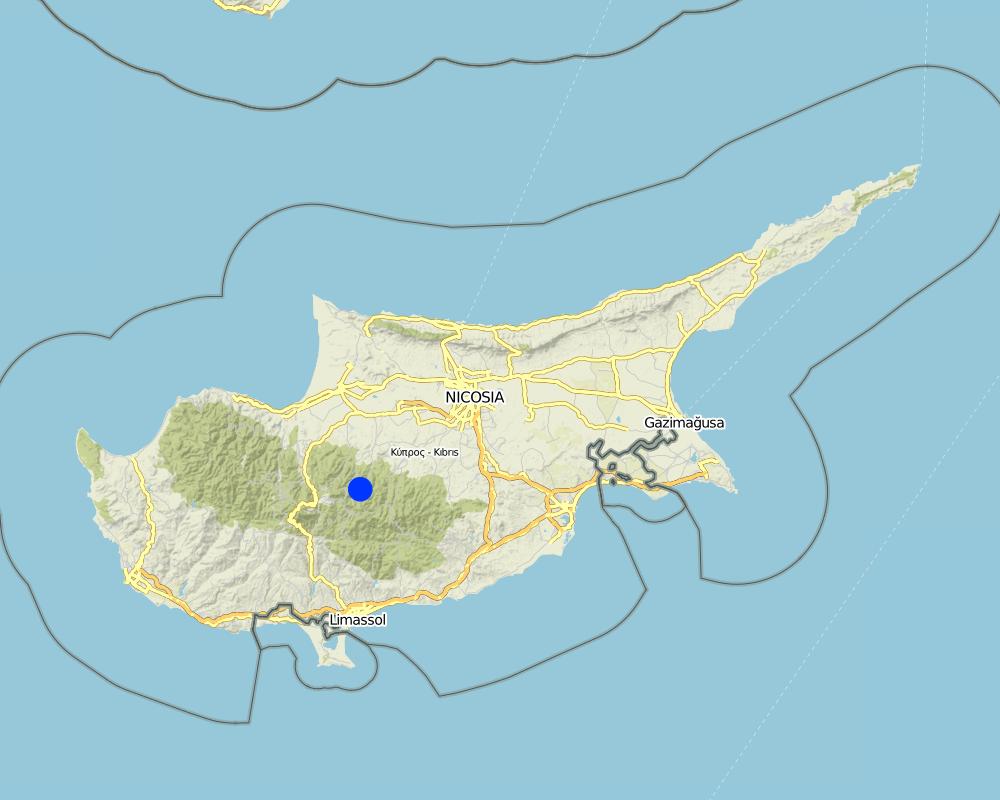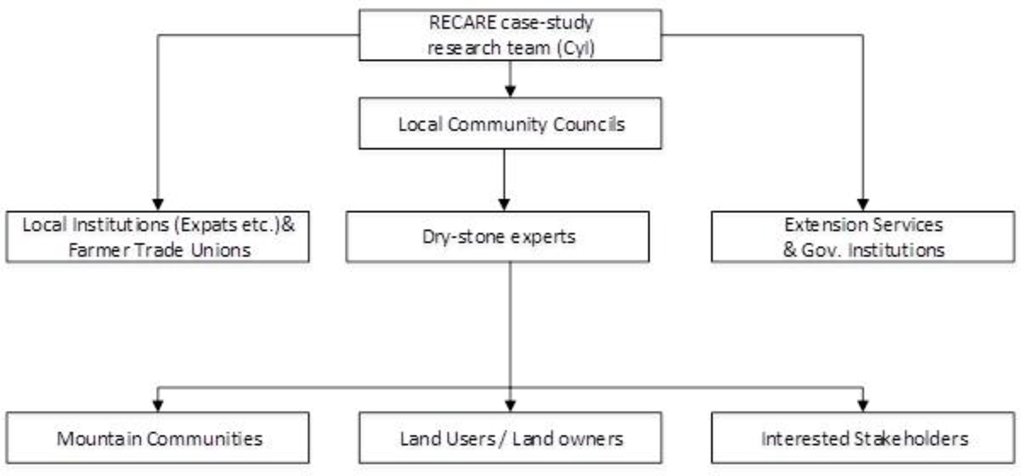Community-based maintenance and rehabilitation of agricultural terraces in mountain environments [Chypre]
- Création :
- Mise à jour :
- Compilateur : Christos Zoumides
- Rédacteur : –
- Examinateur : Fabian Ottiger
Κοινοτική συμμέτοχη για συντήρηση και αποκατάσταση ορεινών γεωργικών αναβαθμίδων (Greek)
approaches_2537 - Chypre
Voir les sections
Développer tout Réduire tout1. Informations générales
1.2 Coordonnées des personnes-ressources et des institutions impliquées dans l'évaluation et la documentation de l'Approche
Spécialiste GDT:
Burggemann Adriana
The Cyprus Institute
Nicosia
Chypre
Nom du projet qui a facilité la documentation/ l'évaluation de l'Approche (si pertinent)
Preventing and Remediating degradation of soils in Europe through Land Care (EU-RECARE )Nom du ou des institutions qui ont facilité la documentation/ l'évaluation de l'Approche (si pertinent)
The Cyprus Institute (The Cyprus Institute) - Chypre1.3 Conditions relatives à l'utilisation par WOCAT des données documentées
Quand les données ont-elles été compilées (sur le terrain)?
01/09/2015
Le compilateur et la(les) personne(s) ressource(s) acceptent les conditions relatives à l'utilisation par WOCAT des données documentées:
Oui
1.4 Références au(x) questionnaire(s) sur les Technologies de GDT
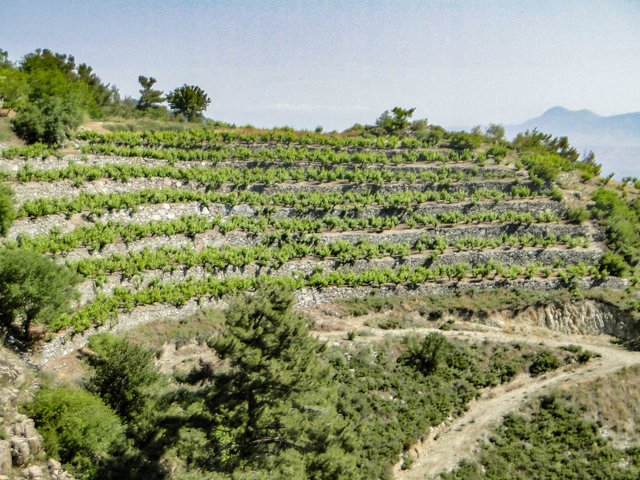
Agricultural terraces with dry-stone walls [Chypre]
Dry-stone terraces built to create agricultural land, minimise soil erosion and retain soil moisture on steep mountain slopes.
- Compilateur : Christos Zoumides
2. Description de l'Approche de GDT
2.1 Courte description de l'Approche
Maintenance and rehabilitation of traditional dry-stone terrace walls for agricultural use, through science-society cooperation, community engagement and motivation, and assistance to land users.
2.2 Description détaillée de l'Approche
Description détaillée de l'Approche:
Aims / objectives: The main objective of the approach is the restoration and rehabilitation of traditional dry-stone terraces in Mediterranean mountain environments. Large areas around mountain communities have been converted to agricultural terraces. The depopulation of these rural mountain communities and the high farming costs have led to the gradual reduction of farming activities. Consequently, many of the mountain terraces are no longer cultivated and dry-stone walls are not well maintained, causing a domino effect of collapsing terraces. Soil erosion by water has been identified as the main soil threat in degraded and poorly vegetated terraces.
The approach has been developed by the Cyprus Institute research team and aims at motivating the mountain communities, land users/owners, local institutions and other interested stakeholders to better organise themselves and collaborate and join forces in maintaining these terraces.
Methods: The approach is based on participatory principles. More precisely, the science-society cooperation approach is materialised through the organization of practical (hands-on) public events, where dry-stone experts guide the participants, land users/owners, local population, expats (families that have moved to the urban areas) and scientific stakeholders, in collectively maintaining collapsed and/or poorly maintained terraces. All parties engaged in the implementation of the approach on voluntary basis.
Stages of implementation: A pool of local and external stakeholders was prepared by the research team using snowball sampling. Key stakeholders identified include community leaders, land users/owners, dry-stone experts, local institutions, agricultural extension services and farmer unions.
Leaders of the three mountain communities agreed to co-organise with the research team one participatory terrace rehabilitation event in each community. Land users/owners, expats and other interested stakeholders (general public) were identified as the main target groups of these events. Each community identified dry-stone experts that were willing to work and lead the workshops on voluntary basis. Demonstration sites were selected by the research team, the community leaders and dry-stone experts, based on the extent of terrace degradation, accessibility/visibility of the site and feasibility criteria. Farmer unions and extension service officers were also engaged in the process. The events were advertised through social media, as well as with flyers and posters in central locations within the communities.
During the events, information was provided by researchers and dry-stone experts to raise the awareness of participants on the environmental and cultural importance of dry-stone terraces. In addition, the learning-by-doing process was guided by experts who explained to the participants the best practices in reconstructing the collapsed terraced walls.
Three public events were organized in the first year and a similar set of three events will be organized in the second year. Additional funds are being sought to continue these activities. The sustainability of communal terrace maintenance will also be discussed with the community leaders and active volunteers during the second year.
Role of stakeholders: The research team conceptualised the approach. The organisation tasks for the participatory rehabilitation events were shared among the research team and the local communities. Expats (families that have moved to the urban areas) associations and farmer unions informed their members to join the events. Dry-stone experts had the leading role during the events, as the reconstruction of collapsed terrace walls was based on their guidance. Extension service officers provided information on available subsidy schemes. During the events all stakeholders, including land users/owners and other interested people, worked together to maintain the terraces.
Other important information: The events attracted people beyond the stakeholders originally identified; the approach was adopted by other projects/communities in Cyprus.
2.3 Photos de l'approche
2.5 Pays/ région/ lieux où l'Approche a été appliquée
Pays:
Chypre
Région/ Etat/ Province:
Nicosia
Autres spécifications du lieu :
Northeast Pitsilia
Map
×2.6 Dates de début et de fin de l'Approche
Indiquez l'année de démarrage:
2015
Date (année) de fin de l'Approche (si l'Approche n'est plus appliquée):
2018
2.7 Type d'Approche
- Recent local initiative in the framework of the RECARE research project
2.8 Principaux objectifs de l'Approche
The Approach focused mainly on SLM with other activities (terrace maintenance, hands-on training, community conservation, participatory approach, stakeholder engagement, awareness-raising)
• To strengthen science-society cooperation in solving land degradation issues in terraced mountain environments.
• To build capacity for planning, organisation and implementation of participatory soil conservation activities, eventually leading to sustainable local institutions that maintain traditional know-how and specialised in terrace maintenance.
• To improve joint learning activities between farmers, terrace experts and interested stakeholders.
• To rehabilitate abandoned and collapsed terraces, reduce soil erosion and maintain the production capacity of soils in Troodos Mountains.
The SLM Approach addressed the following problems: • Collapsing of dry-stone walls, surface run-off and loss of soil (erosion) in sloping land that has been accumulated behind the terrace walls
• Depopulation of mountain rural communities and land abandonment
• Loss of indigenous knowledge
• Weak institutional organisation and limited incentives (low economic returns) for terrace maintenance
2.9 Conditions favorisant ou entravant la mise en œuvre de la(des) Technologie(s) appliquée(s) sous l'Approche
normes et valeurs sociales/ culturelles/ religieuses
- entrave
Land abandonment, rural depopulation, lack of motivation.
Treatment through the SLM Approach: Organise frequent terrace maintenance events to stimulate interest, invite and engage expats to participate.
disponibilité/ accès aux ressources et services financiers
- entrave
Low economic return from terrace agriculture.
Treatment through the SLM Approach: Engage, motivate and train volunteers through public terrace maintenance events.
cadre institutionnel
- entrave
There are no formal or informal institutions for terrace rehabilitation.
Treatment through the SLM Approach: The sustainability of communal terrace maintenance will be discussed with the community leaders and active volunteers during the second year.
cadre juridique (régime foncier, droits d'utilisation des terres et de l'eau)
- entrave
Terraced land is privately owned; no maintenance can be done without the approval of land owners. Demonstration sites are privately owned; the rehabilitation events on terraces were undertaken with the approval of land owners.
Treatment through the SLM Approach: Community leaders request the approval of land owners.
connaissances sur la GDT, accès aux supports techniques
- entrave
Loss of indigenous knowledge
Treatment through the SLM Approach: The terrace events are led by terrace artisans (dry-stone experts) to practically demonstrate and pass the technical know-how to the next generation. Efforts were made to engage terrace experts from different communities.
charge de travail, disponibilité de la main-d'œuvre
- entrave
Terrace maintenance is a laborious activity.
Treatment through the SLM Approach: The pubic terrace maintenance events aim to build the capacity of a large group of people (volunteers) to engage in terrace maintenance.
3. Participation et rôles des parties prenantes impliquées dans l'Approche
3.1 Parties prenantes impliquées dans l'Approche et rôles
- exploitants locaux des terres / communautés locales
Land users including terrace artisans
Land users were involved as individuals. Representatives of farmers unions were engaged in the process
- chercheurs
The Cyprus Institute (research institution)
Terrace experts, researchers and extension services
- secteur privé
The Cyprus Institute (research institution)
- gouvernement local
Local community councils
- gouvernement national (planificateurs, décideurs)
- organisation internationale
- People (volunteers) that attended the hands-on events
Participants of the event (mountain communities, interested stakeholders)
Si plusieurs parties prenantes sont impliquées, indiquez l'organisme chef de file ou l'institution responsable:
The approach was primarily designed by The Cyprus Institute (research institution) [1]. The rehabilitation events are co-organised with the support of local community councils, land users and terrace experts [2].
3.2 Participation des exploitants locaux des terres/ communautés locales aux différentes phases de l'Approche
| Participation des exploitants locaux des terres/ communautés locales | Spécifiez qui était impliqué et décrivez les activités | |
|---|---|---|
| initiation/ motivation | interactive | Jointly developed by The Cyprus Institute (research institution) and local community leaders |
| planification | interactive | Jointly developed by a research institution, terrace artisans and local community leaders |
| mise en œuvre | interactive | Jointly implemented by all stakeholders involved |
| suivi/ évaluation | aucun | Monitoring and evaluation of the approach and the restored terraces is undertaken by The Cyprus Institute scientists |
| Research | aucun |
3.3 Diagramme/ organigramme (si disponible)
Description:
The research team identified key stakeholders using snowball sampling; these include community leaders, dry-stone experts, local institutions, agricultural extension services and farmer unions. Community leaders agreed to co-organise with the research team community-based terrace rehabilitation events; land users/owners, mountain communities and other interested stakeholders (general public) were identified as the main target groups of these participatory events. Dry-stone experts had the leading role during the events, as the reconstruction of collapsed terrace walls was based on their guidance. During the events all stakeholders, including land users/owners and other interested people, worked together to maintain the terraces. In addition, information was provided by researchers to raise the awareness of participants on the environmental and cultural importance of dry-stone terraces.
Auteur:
Christos Zoumides
3.4 Prises de décision pour la sélection de la Technologie/ des Technologies
Les décisions concernant la sélection de la(des) Technologie(s) ont elles été prises:
- by SLM specialists (researchers) in collaboration
Expliquez:
The construction and maintenance of dry-stone terrace walls is an indigenous technology which is applied by land users and terrace artisans (dry-stone wall expert builders) that have the required skills and technical know-how. The initiative was taken by SLM specialists who are concerned about the land degradation and abandonment in mountain terrace areas.
Decisions on the method of implementing the SLM Technology were made by mainly by SLM specialists with consultation of land users. The implementation stage of terrace maintenance is led by terrace experts, who have the required know-how. During the hands-on events, they explain the appropriate techniques; land-users and participants of the events help the experts in maintaining and re-constructing the collapsed dry-stone walls and therefore learn from direct experience.
4. Soutien technique, renforcement des capacités et gestion des connaissances
4.1 Renforcement des capacités/ formation
Une formation a-t-elle été dispensée aux exploitants des terres/ autres parties prenantes?
Oui
Spécifiez qui a été formé:
- exploitants des terres
- Participants of the events
Si pertinent, spécifiez le genre, l'âge, le statut, l'ethnie, etc.
Both men and women of all ages.
Formats de la formation:
- zones de démonstration
Thèmes abordés:
How dry-stone terraces are restored and maintained (technique) and their importance in reducing soil erosion in mountain slopes (awareness).
4.2 Service de conseils
Les exploitants des terres ont-ils accès à un service de conseils?
Oui
Spécifiez si le service de conseils est fourni:
- dans des centres permanents
Décrivez/ commentez:
Name of method used for advisory service: Demonstration of terrace maintenance by experts; participation of land users and the general public; Key elements: Selection and preparation of collapsed terraces to be restored (terrace experts, researchers, community leaders), Demonstration and hands-on terrace maintenance workshops with the participation of land users and the general public; good and bad practices explained.; One agricultural extension service officer participated in these events, discussed the method with land users and SLM experts and provided information on available subsidies.
Advisory service is inadequate to ensure the continuation of land conservation activities; Extension services provide general directions on terrace maintenance and available subsidy schemes to interested land users; they are not sufficiently trained in dry-stone wall construction and they have insufficient human and financial resources.
4.3 Renforcement des institutions (développement organisationnel)
Des institutions ont elles été mises en place ou renforcées par le biais de l'Approche?
- oui, modérément
Spécifiez à quel(s) niveau(x), ces institutions ont été renforcées ou mises en place:
- local
Précisez le type de soutien:
- renforcement des capacités/ formation
Donnez plus de détails:
One of the aims of the approach is to develop sustainable local institutions for terrace maintenance; this will be discussed with the community leaders and active volunteers during the second year.
4.4 Suivi et évaluation
Le suivi et l'évaluation font ils partie de l'Approche? :
Oui
Commentaires:
bio-physical aspects were regular monitored by project staff through measurements; indicators: Erosion rate (Sediment Traps)
technical aspects were regular monitored by project staff through measurements; indicators: Terrace wall displacement (3D terrace model)
no. of land users involved aspects were ad hoc monitored by project staff through measurements; indicators: No. of land users (attendance list)
Number of non-land users involved aspects were ad hoc monitored by project staff through measurements; indicators: Number of non-land users involved
There were no changes in the Approach as a result of monitoring and evaluation: Monitoring is at its early stage.
There were no changes in the Technology as a result of monitoring and evaluation: Dry-stone terracing is a well-established indigenous technology for the mountain communities; the technical know-how however is gradually disappearing due to rural depopulation and land abandonment.
4.5 Recherche
La recherche a-t-elle fait partie intégrante de l’Approche?
Oui
Spécifiez les thèmes:
- technologie
- Monitoring/modelling erosion, particip. research
Donnez plus de détails et indiquez qui a mené ces recherches:
By researchers: Monitoring and modelling soil erosion (PESERA model), monitoring the stability of dry-stone terrace walls (3D model) and participatory research.
Research was carried out on-farm
5. Financement et soutien matériel externe
5.1 Budget annuel de la composante GDT de l'Approche
Si le budget annuel précis n'est pas connu, indiquez une fourchette:
- < 2 000
Commentez (par ex. principales sources de financement/ principaux bailleurs de fonds):
Approach costs were met by the following donors: private sector (Cost for snacks and drinks offered to the event’s participants): 50.0%; local government (district, county, municipality, village etc) (Cost for preparing the site for restoration, stones.): 50.0%
5.2 Soutiens financiers/ matériels fournis aux exploitants des terres
Les exploitants des terres ont-ils reçu un soutien financier/ matériel pour la mise en œuvre de la Technologie/ des Technologies?
Non
5.3 Subventions pour des intrants spécifiques (incluant la main d'œuvre)
- aucun
Si la main d'œuvre fournie par les exploitants des terres était un intrant substantiel, elle était:
- volontaire
Commentaires:
Lunch-snacks, drinks and caps are provided to participants – small gifts are given to experts for their contribution.
Community members prepared the demo sites and used their own tools, local communities supplied extra stones when needed free of charge – all participants were engaged on voluntary basis.
5.4 Crédits
Des crédits ont-ils été alloués à travers l'Approche pour les activités de GDT?
Non
6. Analyses d'impact et conclusions
6.1 Impacts de l'Approche
Est-ce que l'Approche a aidé les exploitants des terres à mettre en œuvre et entretenir les Technologies de GDT?
- Non
- Oui, un peu
- Oui, modérément
- Oui, beaucoup
Well maintained terraces improve drainage and minimise soil loss.
Est-ce que l'Approche a autonomisé les groupes socialement et économiquement défavorisés?
- Non
- Oui, un peu
- Oui, modérément
- Oui, beaucoup
No socially and economically disadvantaged groups were identified.
Est-ce que l'Approche a amélioré les questions foncières et des droits d'utilisation qui entravent la mise en œuvre des Technologies?
- Non
- Oui, un peu
- Oui, modérément
- Oui, beaucoup
Property rights was not an issue for the implementation of the approach. The problem is unlikely to be overcome in the near future. Property rights are not expected to become an issue for the implementation of the approach; stakeholders have been collaborating without raising such concerns.
Did other land users / projects adopt the Approach?
- Non
- Oui, un peu
- Oui, modérément
- Oui, beaucoup
The approach has been adopted by another project in Cyprus (Local Development Pilot Project for the Wine-villages of Limassol – LDPP); many participants express their interest in organizing similar events in other communities in Cyprus.
Did the Approach lead to improved livelihoods / human well-being?
- Non
- Oui, un peu
- Oui, modérément
- Oui, beaucoup
Although well maintained terraces can potentially improve the livelihoods of rural population, this was not the main focus of the approach.
Did the Approach help to alleviate poverty?
- Non
- Oui, un peu
- Oui, modérément
- Oui, beaucoup
Poverty was not identified and not one of the targets of the approach.
6.2 Principale motivation des exploitants des terres pour mettre en œuvre la GDT
- réduire la charge de travail
Participatory rehabilitation
- affiliation à un mouvement/ projet/ groupe/ réseaux
Motivation through the RECARE project
- améliorer l'esthétique
Maintain collapsed and degraded dry-stone walls
- environmental consciousness, moral, health
Reduce soil erosion
- Cultural value
Maintain cultural landscapes
6.3 Durabilité des activités de l'Approche
Les exploitants des terres peuvent-ils poursuivre ce qui a été mis en œuvre par le biais de l'Approche (sans soutien extérieur)?
- oui
Si oui, décrivez de quelle manière:
Local communities can potentially organise better themselves and with the collaboration of land users/owners and SLM experts, they can organise such community-based conservation events on an annual basis. Thus the approach can eventually be sustained without scientific (external) support.
6.4 Points forts/ avantages de l'Approche
| Points forts/ avantages/ possibilités du point de vue de l'exploitant des terres |
|---|
| Participation of people reduced the workload required to maintain terraces. (How to sustain/ enhance this strength: More frequent events are welcomed.) |
| Community based conservation activities have contributed to better institutional organisation. (How to sustain/ enhance this strength: Engage more local stakeholders in future events.) |
| Points forts/ avantages/ possibilités du point de vue du compilateur ou d'une autre personne ressource clé |
|---|
| Community conservation was insofar successful in maintaining selected demonstration sites. (How to sustain/ enhance this strength: Maintain the interest of stakeholders by organising similar events on an annual basis.) |
| Capacity building activities increase the participation of stakeholders. (How to sustain/ enhance this strength: Continue the approach for further engagement.) |
6.5 Faiblesses/ inconvénients de l'Approche et moyens de les surmonter
| Faiblesses/ inconvénients/ risques du point de vue de l’exploitant des terres | Comment peuvent-ils être surmontés? |
|---|---|
| Mountain farming is less cost-effective than in the plains. | Motivate the younger generation to engage in part-time farming. |
| The approach cannot be implemented on bigger scale without economic incentives. | Utilise available community/subsidy funds for small cash compensation to experts. |
| Small holdings and land fragmentation are constraints for cost-effective agriculture. | Reconsideration of land consolidation schemes. |
| Faiblesses/ inconvénients/ risques du point de vue du compilateur ou d'une autre personne ressource clé | Comment peuvent-ils être surmontés? |
|---|---|
| Aging of the dry-stone experts. | Train young land users/owners on dry-stone terracing. |
| The community leaders tend to be more conservative than the SLM experts. | Gradually convince them to think bigger. |
7. Références et liens
7.1 Méthodes/ sources d'information
- visites de terrain, enquêtes sur le terrain
- interviews/entretiens avec les exploitants des terres
Liens et modules
Développer tout Réduire toutLiens

Agricultural terraces with dry-stone walls [Chypre]
Dry-stone terraces built to create agricultural land, minimise soil erosion and retain soil moisture on steep mountain slopes.
- Compilateur : Christos Zoumides
Modules
Aucun module trouvé


